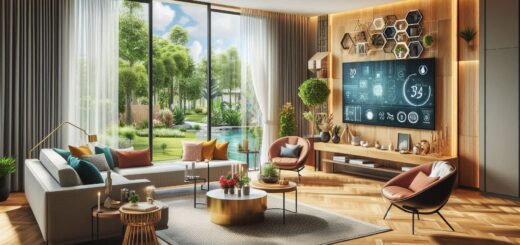Top 10 Lighting Ideas to Brighten Every Room in Your Home
Lighting plays a pivotal role in creating ambiance, enhancing functionality, and setting the mood for any space. Whether you’re looking to refresh your home’s look or make each room more inviting, understanding various lighting strategies can make all the difference. This article explores the top 10 lighting ideas to brighten every room in your home, from natural light to modern smart lighting systems.
Table of Contents
The Role of Natural Light in Home Design
Natural light isn’t just something we appreciate when the sun shines bright; it’s an essential part of how our homes feel and function. When harnessed properly, it can truly transform a space. It’s not only great for your energy bill, but it also brings in warmth, makes your rooms feel bigger, and creates a welcoming atmosphere that no artificial light can match.
The Many Benefits of Natural Light
There’s a reason we feel better when sunlight fills a room. Exposure to natural light is known to boost your mood and improve productivity. It has a calming effect that helps reduce stress—think about how nice it feels to relax with sunlight streaming through your windows. Plus, natural light gives a soft, flattering glow to everything in your home, making everything look more inviting.
Plants, too, thrive with sunlight. They soak it in and flourish, adding life to your home. Whether you have a jungle of houseplants or just a few on the windowsill, they’ll thank you for those sunny rays.
How to Maximize Natural Light
We all want those beams of sunlight without the glare, right? Here’s how to let the sunshine in while keeping things comfortable:
- Sheer Curtains and Blinds: Instead of blocking the light completely with heavy curtains, go for sheer ones or light-filtering blinds. This allows sunlight to pour in while keeping your privacy intact. It’s like letting the outdoors inside without feeling exposed.
- Strategic Mirror Placement: Want to make your room feel brighter? Place mirrors where they can reflect the natural light coming in through the windows. It’s a simple trick that makes a room feel larger and more open, almost as if you’re doubling the sunshine.
Home Lighting Ideas That Transform Every Room
Lighting can make or break the vibe of your home. From cozy corners to lively family spaces, the right lighting doesn’t just brighten up a room—it sets the mood, enhances functionality, and adds style. Let’s explore how to light up every room in your home beautifully and practically.
1. Living Room Lighting Ideas
Your living room is the heart of the home—where you spend time with loved ones, unwind after a busy day, or just kick back and enjoy some “me time.” So, having the right lighting can make all the difference in setting the tone for whatever you’re doing. Here’s how to make sure your space has the perfect lighting for every occasion.
Layered Lighting for Comfort
Combine overhead lighting like chandeliers or recessed fixtures with cozy table lamps or floor lamps. Want to highlight your favorite artwork or that gorgeous fireplace? Accent lights, like wall sconces, do the trick beautifully.
Dimmable Lights for Flexibility
Dimmable lights let you control the vibe, whether you’re having a lively game night or winding down with a movie. Pro tip: Make sure both your ceiling fixtures and lamps are dimmable to give you the most flexibility.
Use Reflective Surfaces
Got a mirror or glossy furniture? Place them strategically to bounce light around, making the room feel bigger and brighter. A mirror near a window can work wonders!
Extra Tips for Living Room Lighting:
- Use Multiple Light Sources: Don’t rely on just one light. Instead, layer multiple sources (like lamps, overhead lights, and accent lights) to give the room depth. This will create a warm, inviting glow that changes depending on the time of day or activity.
- Switch Up the Bulbs: Light bulbs come in different tones, from warm to cool. For a cozy atmosphere, opt for warmer bulbs (around 2700K–3000K). For a more energetic vibe (say, if you’re reading or working), cooler bulbs (4000K and up) do the trick. You can even experiment with color-changing bulbs for a bit of fun!
- Focus on Functionality: Make sure your lighting also serves the purpose of the room. If you love reading in the living room, add a floor lamp that gives off bright, focused light near your favorite chair. It’s all about balancing ambiance with practicality.
- Consider Smart Lights: If you’re into tech, smart bulbs that you can control via phone or voice assistant make life a little easier. Adjusting brightness or color temperature at the touch of a button is a nice luxury to have, especially when you’re in the middle of a movie or hosting guests.
2. Dining Room Lighting Ideas
Your dining room is more than just a place to eat—it’s where conversations flow, laughter fills the air, and memories are made. So, the lighting needs to reflect that welcoming, warm vibe. Let’s look at how to light up this space, making it both functional and chic.
Statement Chandelier
Choose a chandelier that fits your table and dining room style. Go for ornate crystals for a classic vibe or sleek designs for a modern twist. It’s the crown jewel of the space!
Pendant Lights for Intimacy
Hanging pendants low over the table gives a warm, intimate glow. Bonus tip: Group pendants in odd numbers (like three) for a modern, balanced look.
Wall Sconces for Ambiance
Wall sconces add that soft, ambient glow perfect for cozy dinners. Place them along the walls to create an inviting atmosphere.
Extra Tips for Dining Room Lighting:
- Use Dimmers: To match the mood, consider installing dimmers for your chandelier, pendants, and wall sconces. This way, you can adjust the lighting depending on the occasion. Bright lights are great for lively dinner parties, but a softer glow works wonders for a romantic meal or casual gathering.
- Mind the Height: When hanging pendant lights, make sure they’re at the right height—typically about 30-36 inches above the table. This ensures the light is focused on the meal without getting in the way of conversation or making it hard to see across the table.
- Consider Layering Light: Combine your chandelier or pendant lights with recessed lighting or floor lamps around the room. This creates a layered effect that adds depth to the space and makes it feel more balanced.
3. Kitchen Lighting Ideas
Ah, the kitchen—a place where the magic happens, and yes, sometimes the mess too! Whether you’re cooking up a storm or just grabbing a snack, lighting in the kitchen needs to be spot-on. Let’s break down the best lighting ideas for a well-lit, functional, and stylish kitchen.
Under-Cabinet Lighting
LED strip lights under cabinets brighten countertops for prep work and eliminate pesky shadows.
Recessed Lighting
Flush and discreet, recessed lights give an even glow across the room. Place them strategically where you cook and work the most.
Pendant Lights Over the Island
If you’ve got an island, add pendant lights to make it a functional and stylish centerpiece. Match the design to your kitchen’s theme—industrial, modern, or rustic.
Extra Tips for Kitchen Lighting:
- Layer Your Lighting: Don’t rely on just one type of lighting. Combine under-cabinet lights, recessed lighting, and pendant lights to create a layered effect that makes your kitchen feel balanced and functional.
- Dimmable Features: If you like to switch between different activities, consider adding dimmer switches. This way, you can go from bright, task-oriented lighting to a softer, more relaxed glow when you’re enjoying a meal or chatting with family.
- Energy Efficiency: Kitchens can use a lot of light, so energy-efficient LED options are ideal. They last longer and help keep your energy bills in check while still providing ample lighting for all your cooking and dining needs.
4. Bedroom Lighting Ideas
Your bedroom is your sanctuary, a place to unwind, recharge, and escape the chaos of the day. The lighting here should create a calming atmosphere while being practical for all those nighttime rituals—whether it’s reading, getting ready for bed, or just relaxing. Here are some lighting ideas to make your bedroom feel cozy, soothing, and functional.
Soft Ambient Lighting
Warm-toned bulbs in a chandelier or flush-mount fixture create a cozy vibe. Skip harsh, cool lighting—it makes the room feel too sterile.
Bedside Lamps
Adjustable bedside lamps are a dream for readers. Wall-mounted options are great if you’re short on space.
Floor Lamps for Corners
Got an empty corner? A floor lamp can fill the space and add a touch of personality. Choose one with dimming options for extra coziness.
Bonus Tips for Bedroom Lighting:
- Layered Lighting: Combine ambient lighting (for overall room illumination), task lighting (like bedside lamps), and accent lighting (such as soft string lights or a decorative table lamp). This creates a multi-dimensional lighting scheme that’s both functional and beautiful.
- Dimmer Switches: Consider installing dimmer switches in your bedroom. They allow you to adjust the lighting as needed—bright for mornings or soft and dim for evenings. It’s the best way to keep the mood exactly how you want it.
- Light Placement: Don’t forget about placement. Be mindful of the light fixtures you choose and where they go. Too much direct light near your bed can be overwhelming, while well-placed lamps and overhead lights will create a softer, more balanced feel.
5. Bathroom Lighting Ideas
Your bathroom is one of the most functional spaces in your home, but that doesn’t mean it can’t look good too. Whether you’re getting ready for the day or unwinding in the tub, the right lighting can enhance both the mood and practicality of the space. Here’s how to get the lighting just right:
Vanity Lighting
Side-mounted sconces are perfect for even face illumination. No shadows = flawless makeup and grooming.
Bright Overhead Lighting
Recessed lights or flush mounts ensure the whole space is bright and welcoming, even in windowless bathrooms.
Accent Lighting for the Bathtub
Want a spa-like feel? Add LED strip lights under the tub or in shower niches. It’s a small touch that adds big relaxation vibes.
Bonus Tips for Bathroom Lighting:
- Mirror Lighting: If you spend a lot of time in front of the mirror, consider adding a lighted mirror or backlit mirrors. These provide even light, ensuring you can see yourself clearly without the shadows that can come from traditional fixtures.
- Dimmable Lights: Not all bathroom activities require full-on lighting. Having dimmable lights can be a great way to set the mood when you’re soaking in the tub or enjoying a relaxed evening. You can brighten the room for tasks and dim it when you want to wind down.
- Layered Lighting: Layering different types of lighting—ambient, task, and accent—will ensure your bathroom is both functional and beautiful. This gives you flexibility, so you can adjust the lighting for whatever you’re doing in there.
6. Home Office Lighting Ideas
Good lighting in your home office is more than just about brightening the room—it’s about creating a space that fosters focus and minimizes distractions. Whether you’re working on a big project or just checking emails, having the right lighting can make a world of difference in both productivity and comfort. Here’s how to light up your home office the right way:
Desk Lamp for Focus
An adjustable desk lamp is a must. Choose one with multiple brightness settings to reduce eye strain during those long workdays.
Overhead Ambient Lighting
Combine your task lighting with an overhead fixture to keep the whole room well-lit without adding glare to your screens.
Maximize Natural Light
If possible, position your desk near a window to soak up that natural light—it boosts energy and mood! Use blinds or sheer curtains to control glare.
Bonus Tips for Home Office Lighting:
- Avoid Overhead Glare: If your workspace has overhead lighting, position it away from your computer screen to prevent glare. You don’t want to struggle with reflections while trying to focus.
- Task Lighting Flexibility: An adjustable desk lamp is great for controlling the light exactly where you need it, but if you have multiple tasks or different zones in your office, consider adding additional task lighting (like clip-on lamps or light strips) for extra flexibility.
- Color Temperature: The color temperature of your lighting can also impact your productivity. A cool, neutral white (4000K) is ideal for work environments, as it helps with concentration and focus without being too harsh.
7. Hallway Lighting Ideas
Hallways often get overlooked when it comes to lighting, but they play an important role in connecting different areas of your home. The right lighting can make your hallway feel less like a transition space and more like an inviting path. Here’s how to light up your hallway effectively:
Recessed or Track Lighting
These fixtures brighten narrow spaces without taking up room. Bonus: Use track lighting to spotlight family photos or artwork.
Wall Sconces for Ambiance
Add eye-level sconces for a cozy glow. They’re great for long hallways and help avoid dark, shadowy corners.
Motion-Activated Lights
Convenient and energy-efficient, motion-activated lights are perfect for nighttime trips through the hallway.
Bonus Tips for Hallway Lighting:
- Layer Lighting: If your hallway has multiple uses or different zones (like near a closet or stairway), consider using a mix of ambient lighting and task lighting to highlight those areas.
- Dimmer Switch: Adding a dimmer switch to your hallway lights can help you adjust the brightness based on the time of day or mood you want to create. Lower brightness works well at night, while higher settings are great for daytime.
- Light Placement: In longer hallways, evenly spaced lighting fixtures can avoid creating dark pockets. If you have a smaller hallway, a central light fixture or a couple of wall sconces can provide just enough illumination.
8. Entryway Lighting Ideas
Your entryway is the first space guests see when they walk into your home, so lighting here is crucial. It sets the tone for the rest of your house—welcoming and stylish or cold and uninviting. With the right lighting choices, you can transform this transitional area into a warm and functional space. Let’s break down some smart lighting ideas for your entryway:
Statement Pendant Light
A bold pendant light or chandelier instantly makes your entryway feel stylish and welcoming.
Wall Sconces or Table Lamps
Layer your lighting with a table lamp on a console or a pair of wall sconces. The combination feels warm and functional.
Mirrors to Reflect Light
A well-placed mirror near a light source can make a small entryway feel bigger and brighter.
Bonus Tips for Entryway Lighting:
- Layering Light Sources: Combine overhead lighting with softer, ambient light from lamps or sconces. This creates a dynamic lighting effect and ensures your entryway isn’t too bright or too dim.
- Dimmer Switch: Adding a dimmer switch to your entryway light allows you to adjust the intensity depending on the time of day or the mood you want to set. Lower brightness works well in the evening, while a brighter setting is perfect for mornings.
- Lighting Placement: Be mindful of the light placement in your entryway. If the space is narrow, place lights near the edges of the room to open it up. For wider areas, center your lighting to create a balanced look.
9. Outdoor Lighting Ideas
When it comes to outdoor lighting, it’s not just about illuminating the space for safety. The right lighting can transform your home’s exterior into a cozy, inviting retreat—perfect for hosting guests or enjoying a quiet evening under the stars. Here are some lighting ideas to help you create a welcoming outdoor atmosphere:
Pathway Lighting
Line your driveway or walkways with solar-powered lights for both safety and charm.
Porch Lights
A warm-toned light near the door feels inviting and adds security. Motion-sensor options are great for added peace of mind.
String Lights for Patios
Got a deck or patio? String lights create a magical atmosphere for outdoor gatherings or quiet evenings.
Bonus Tips for Outdoor Lighting:
- Highlight Landscaping: Use spotlights or uplights to highlight beautiful trees, sculptures, or other features in your garden. This adds a dramatic effect and makes your yard feel like a curated outdoor space.
- Layer Your Lights: Combine different types of lighting, like accent lights, floodlights, and ambient lighting, to create depth and dimension. This will ensure your outdoor space feels balanced and well-lit without being overwhelming.
- Consider the Mood: For relaxed outdoor gatherings, go for soft, warm lighting, like string lights or lanterns. For more functional areas, like pathways or entryways, opt for brighter, cooler lights for clarity and safety.
10. Basement Lighting Ideas
Basements often have the reputation of being dark, cramped, and uninviting. But with the right lighting, you can transform your basement into a bright, functional, and welcoming space. Whether you’re creating a cozy entertainment room, a home gym, or simply need extra storage, here are some lighting ideas to make the most out of your basement’s potential.
Bright Overhead Lighting
Recessed lights are ideal for low ceilings and provide even, bright light across the room.
Floor Lamps for Corners
Brighten up dark corners with floor lamps that have adjustable heads for focused light.
LED Strip Lighting for Shelves
Highlight shelves, media centers, or bar areas with LED strips for a polished, modern touch.
Bonus Tips for Basement Lighting:
- Layer Your Lighting: Mix different types of lighting—task lighting for specific tasks, ambient lighting for overall brightness, and accent lighting for atmosphere. This will create a balanced and functional lighting scheme throughout your basement.
- Light Colors Matter: Light colors, like white or soft warm tones, can help make a basement feel brighter and more open. Avoid cool, harsh lighting, which can make the space feel more cramped and unwelcoming.
- Use Light-Reflective Surfaces: Consider painting walls in light hues and using reflective materials for furniture or décor. This will help bounce light around the room and keep the basement feeling airy and spacious.
Creative Lighting Ideas for Small Spaces: How to Maximize Light and Space Effectively
Small rooms can easily feel cramped or cluttered, but with the right lighting, you can open up the space, making it feel bigger and more inviting. The key is to use lighting that not only serves a purpose but also adds a sense of openness and warmth.
Creative Solutions for Small Spaces to Maximize Light
One of the best tricks for avoiding a small space feeling too confined is using wall-mounted fixtures. These lights save precious floor space and can create a cleaner, more streamlined look. Wall sconces or even wall-mounted pendant lights are great choices for adding light without crowding the room. This also makes it easier to move around, as the light fixtures stay out of the way.
Another clever trick is to use mirrors in your lighting strategy. Placing mirrors across from light sources or near windows reflects natural light, bouncing it around the room and creating the illusion of more space. This works especially well in smaller rooms where light might otherwise be limited. A mirror can serve as a design feature, and when paired with well-placed lighting, it can make a room feel much larger than it actually is.
Multi-Functional Lighting Solutions for Small Rooms
In small spaces, every inch matters, so lighting that serves double duty is a game changer. Consider multi-functional lights that do more than just illuminate. For example, illuminated shelves are both practical and stylish. They provide light for the room while also offering a place to store books, decor, or personal items. Not only do these lights keep things organized, but they add a soft, glowing atmosphere, making the space feel cozy without taking up additional space.
Another option is to choose adjustable lighting that can be repositioned based on your needs. A dimmable desk lamp, for example, gives you control over the ambiance and ensures the room always feels comfortable, whether you’re reading, working, or just relaxing.
Creative and Budget-Friendly DIY Lighting Ideas: Brighten Up Your Space with Handmade Fixtures
Lighting doesn’t have to come with a hefty price tag—sometimes, the best designs are the ones you create yourself. Whether you’re looking to add a personal touch to your home or need a budget-friendly way to brighten up a room, DIY lighting projects can bring warmth and charm to any space.
Popular DIY Lighting Hacks to Get You Started
1. String Lights in Mason Jars
If you’re into rustic decor, this one’s for you. String lights in mason jars create a soft, ambient glow that’s perfect for adding a cozy feel to any room. You can hang them in clusters or line them up on a mantle or bookshelf. The warm light from the bulbs inside the jars gives off a comforting, charming vibe. Plus, it’s a super affordable project!
2. Upcycled Wine Bottles as Pendant Lights
Turn those empty wine bottles into stylish pendant lights. Simply clean the bottles, cut a hole at the base for the bulb socket, and mount them from the ceiling. You can paint or decorate the bottles to match your room’s theme, making this project both sustainable and stylish. It’s a great way to recycle and create something unique for your space.
3. Paper Lanterns for Whimsical Decor
Paper lanterns are a fun way to add a touch of whimsy to any room. You can make them in different shapes, colors, and sizes to create a playful, decorative lighting piece. Hang them in clusters, or make a statement by placing one above a dining table or in a corner. They’re light, airy, and incredibly customizable, making them a go-to for any DIY lighting enthusiast.
Budget-Friendly Tips for DIY Lighting
1. Thrifted Materials for Unique Fixtures
Shopping secondhand is a great way to find materials for DIY lighting projects. Look for old lamps, lanterns, or even candle holders at thrift stores and flea markets. With a little creativity, you can repurpose these items into new lighting fixtures. For example, an old chandelier can be cleaned up and given a modern twist with a coat of spray paint and new lightbulbs.
2. Repurpose Household Items
Before you toss that old teacup, mason jar lid, or wooden crate, consider whether it could make a great lighting element. A teacup could turn into a charming pendant light, and a wooden crate can be used to create an industrial-style lamp. Repurposing everyday items not only saves money but also gives them a new lease on life while adding character to your space.
3. Use LED Strips for Custom Lighting
LED strips are incredibly versatile and can be used in a wide range of DIY lighting projects. You can line shelves, cabinets, or even the edges of mirrors with these strips to create a sleek, modern look. Plus, they’re energy-efficient, making them a great choice for both lighting and saving on electricity.
How to Get Creative with Your DIY Lighting
The beauty of DIY lighting projects is that the possibilities are endless. Think outside the box and don’t be afraid to mix materials. For example, you could use twine to hang up some lightbulbs or transform old CDs into reflective discs for a unique light fixture. The goal is to get creative and personalize your space.
FAQs: Brighten Every Room in Your Home
How can I make a room feel brighter?
To make a room feel brighter, use light-colored walls, furniture, and accessories to reflect light. Add mirrors to bounce natural light around and consider sheer curtains to let sunlight in. Incorporating light fixtures with dimmable options, as well as using white or light shades for furniture, can enhance brightness.
What are the best lights for reading?
The best lights for reading are those that provide focused, comfortable illumination without causing eye strain. An adjustable desk lamp with a flexible neck allows you to direct light where you need it. Opt for LED bulbs with a warm to neutral tone (around 3000K to 4000K) to avoid harsh lighting. Look for lamps with dimming options, so you can adjust brightness according to your preference. Additionally, consider a floor lamp with a swivel head or a clip-on light for reading in bed. A well-lit, well-placed light ensures a comfortable reading experience, keeping your eyes relaxed and engaged.
How do I choose the right chandelier size?
To choose the right chandelier size, consider the room’s dimensions. For dining rooms, aim for a chandelier with a diameter about half to two-thirds the width of the table. In a living room, the chandelier should be proportional to the ceiling height, typically 1/4 of the room’s height.
What are smart lights?
Smart lights are lighting systems that can be controlled remotely via apps, voice commands, or automated schedules. They typically connect to your home’s Wi-Fi or Bluetooth network. These lights offer features like adjusting brightness, color, and even setting mood lighting. Popular smart lighting brands, like Philips Hue or LIFX, allow users to control their lights using devices like smartphones, smart speakers (e.g., Amazon Echo or Google Home), or even integration with home automation systems. Smart lights can help save energy, create ambiance, and enhance convenience, allowing you to turn them on or off from anywhere.
How do I layer lighting in a room?
Layering lighting in a room involves combining different types of lighting to create balance and functionality. Start with ambient lighting, like ceiling fixtures or recessed lights, to provide general illumination. Add task lighting, such as desk or reading lamps, for focused light. Finally, incorporate accent lighting, like wall sconces or spotlights, to highlight artwork or architectural features. This layered approach ensures the room is well-lit and versatile, creating a welcoming atmosphere while meeting specific lighting needs.
What is the most energy-efficient lighting?
LED lights are the most energy-efficient option. They use significantly less energy than traditional incandescent bulbs and last much longer, reducing both energy consumption and replacement costs. Additionally, LEDs produce less heat, making them more efficient for both lighting and overall room temperature management.
Conclusion
Lighting transforms a house into a home by adding personality, comfort, and functionality. Whether you’re seeking elegance with chandeliers or embracing modernity with smart lighting, the right choices can brighten every corner of your space.













